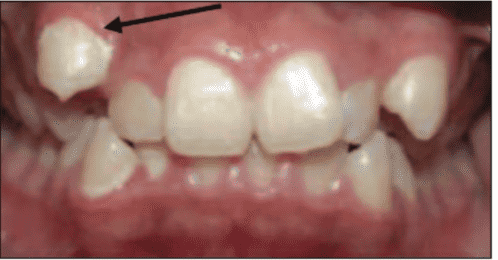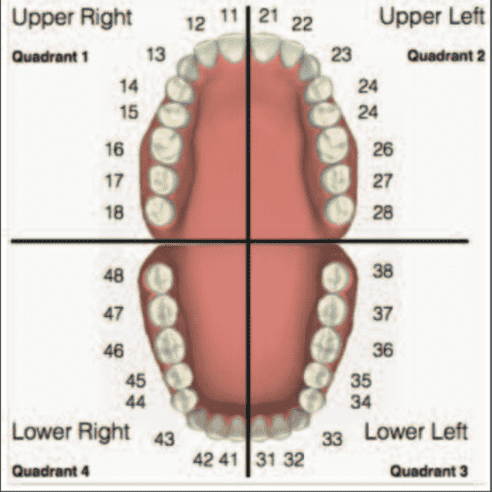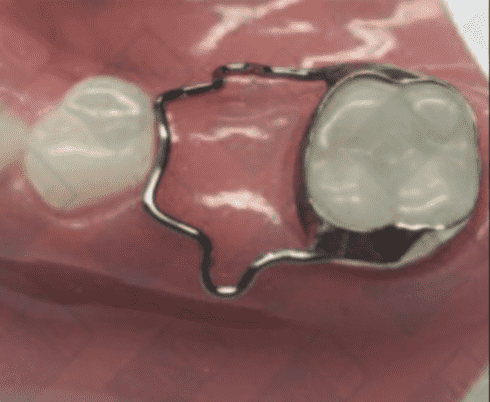
What are”Spacers”? Who NeedsThem?:
Healthy Smiles November 2018

By Dr. Megan

You might have heard of “spacers” when some parents talk about their children having a spacer in their mouth or the need for the spacers to be removed. Space maintainer, the more professional term, refer to appliances used to hold the space needed to maintain the form of the arch in mouth. In most cases when a baby tooth is extracted earlier than it is supposed to fall on its own, a space maintainer is recommended, but why?
Believe it or not, teeth move! This is how braces work. Teeth movements including tilting, shifting or rotating would not be something you could see overnight but they do happen. Whenever a tooth is extracted, most specifically in the back region of the mouth, other teeth could be impacted as well. Therefore we like placing these spacers in situations where we still need to keep those spaces for the grown-up teeth to erupt.
Take a look at picture A and you’ll be able to somewhat appreciate how the dynamic of growing and losing teeth works. A baby tooth, in a normal situation, gets “dissolved” by the tooth under or above it and eventually gets loose and falls out. We like this process to happen in a timely manner, meaning certain teeth fall in certain time period. Children usually lose their bottom front teeth first and the normal age range is 6-7 years, however there is an acceptable margin (earlier or later) of 1 year for any individual. With early (earlier than normal) loss of front teeth, a shift in mid-line may or may not happen, but that is usually not very significant as the back baby teeth.

Back baby teeth are deemed as pillars of the mouth and losing them earlier than they should fall, can have a more significant effect on space and future need to spacers or even braces. So take this case; a 5 year-old kid loses a back 1st baby molar, which usually falls when they are 9-11 years old. What do you think will happen? The adjacent teeth can tilt or shift to get closer together and make that space smaller. Now you might think this will only have esthetic consequences, but the truth is we need that space for another adult tooth to erupt in future. Closing this space could change the position of that new adult tooth.

We call that eruption pattern “ectopic eruption”, meaning it is not in its right place in the arch (Picture B). In some cases the adult tooth may not even come in and we refer to that as a locked out tooth.
These spacers come in different shapes and forms depending on the situation. Let’s divide the mouth into 4 quadrants: top right, top left, bottom right, bottom left (picture C)


For a kid who loses only one baby molar in a quadrant, a unilateral appliance is considered (picture D). We call this spacer a “band and loop”.
However, if he or she loses 2 baby molars on top (right and left) or on bottom (right and left), a bilateral appliance will be considered (picture E).
For older kids, when they are about to have their adult teeth come in soon, these appliances may not be as necessary.
Also, keep in mind that the child’s cooperation level is crucial for making and delivering these appliances.

As much as it is preferred to maintain these spaces for their own benefit, I personally would not choose to do so if patient presents poor cooperation and could get an unpleasant memory out of it.
I amDr. Mojdeh Faraz, AKA Dr. Megan 🙂 I am a Board-certified pediatric dentist at Pajaro Valley Childrens Dental Group. I received my DDS at NYU followed by my speciatly training at Jacobi Medical Center in affiliation with Albert Einstein School of Medicine. My passion in working with children and to be part of their innocent world led me to this fun and fabulous field.
I am proud to work with an amazing crew who are so seasoned when it comes to working with children. They are the reason for the excellent reviews and feedbacks we’ve receive over the years. Please Feel free to come by and visit our fun and child-friendly practice at 230 Green Valley Rd, Freedom, CA 95019.

You May Also Like

How Parks are Surviving the Off-Season: Always Amused November 2018
November 1, 2018
Your Letters and Thoughts: November 2018
November 1, 2018

